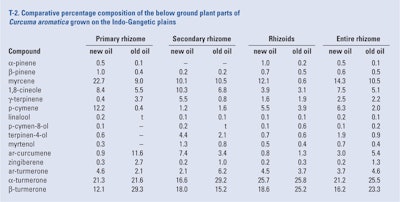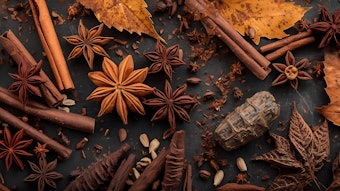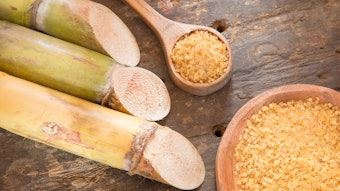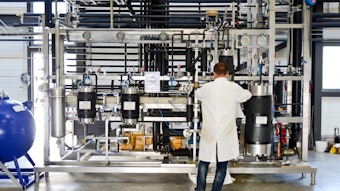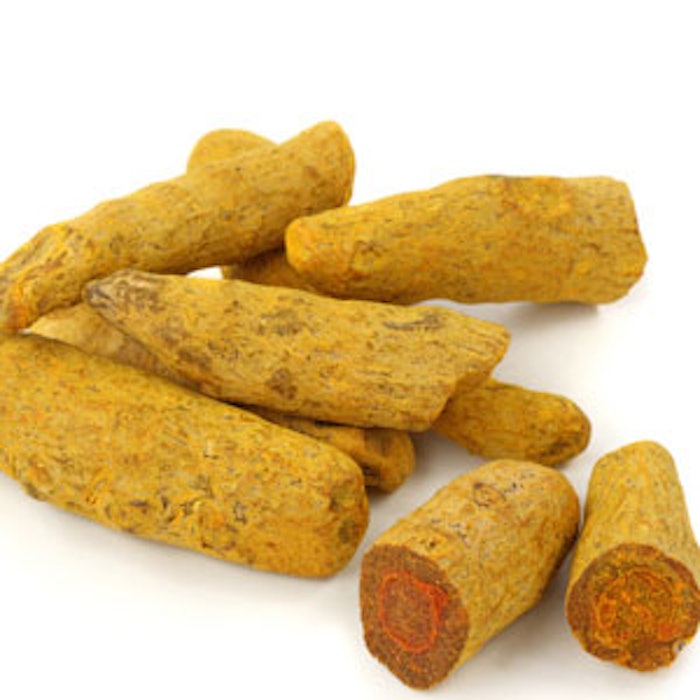
Editor’s note: In part one of this two-part series, columnist Brian M. Lawrence compares the chemical compositions of turmeric oil and Curcuma aromatica.
Turmeric is well-known as the yellow, aromatic spice used in curry powder and numerous Asian culinary dishes. It is the rhizome of Curcuma longa L. (syn. C. domestica Vol.), a member of the ginger (Zingiberaceae) family. India is the largest producer of turmeric, producing in excess of 700,000 metric tonnes annually (Chempakam and Parthasarathy, 2008). As one might expect, there are a plethora of cultivars of turmeric grown in different regions of India, although most are grown in Andhra Pradesh and Tamil Nadu because these states produce approximately 75% of the Indian turmeric.
Curcuma longa is an erect, herbaceous, perennial, strongly tillering plant possessing long, broad lanceolate leaves and a fleshy complex rhizome with an elipsoidal primary tuber. Although it is a perennial, it is propagated vegetatively using rhizome pieces so that the mature rhizome is ready for harvest when the leaves start to turn yellow, some 8-10 months after planting.
The more popular cultivars grown are ‘Duggirala,’ ‘Alleppey,’ ‘Tekurpet,’ ‘Lakadong,’ ‘Amalapuram,’ etc. (Sasikumar, 2001). The average yield of fresh rhizomes is 17–23 metric mt/ha (irrigated crop) and 6.5–9 mt/ha (rainfed crop); however, some of the newly selected cultivars can yield as much as 30–35 mt/ha.
In addition to its use as a spice, turmeric has been used both as a coloring agent and an important medicine, as it possesses a wide range of useful and beneficial biological properties (Bone, 1991). Although it is prized as a spice and medicinal plant, oil is produced from its rhizome generally as part of the two-stage oleoresin process; and since the level of oil extracted is dictated by the customer, an excess of oil is available commercially.
A summary of the literature reveals that turmeric has been reviewed twice before (Lawrence, 1982 and 2000). The present review provides an update of the more recent studies performed on this oil.
Cooray et al. (1988) studied the effect of maturity on rhizome yield and its composition using the main Sri Lankan cultivar as the turmeric understudy. They found the maximum yield of rhizomes producing an optimized level of curcumoid compounds (yellow color) was at nine months after planting. Although the oil yield was higher in younger rhizomes, the total yield per rhizome was low.
Analysis of the oil using GC/MS resulted in the characterization of α-pinene, α-phellandrene, 1,8-cineole, γ-terpinene, terpinolene, zingiberene, β-bisabolene, ar-turmerone and α-turmerone. The oil produced from 9-month-old rhizomes contained α-phellandrene (1.7%), 1.8-cineole (0.9%), ar-turmerone (43.7%) and α-turmerone (32.4%).
Jayaprakasha et al. (2001) used GC-FID and GC/MS and determined that Indian turmeric rhizome oil possessed the following composition:
α-phellandrene (0.4%)
p-cymene (0.4%)
1,8-cineole (1.2%)
(E)-β-ocimene (0.4%)
α-terpineol (0.2%)
cis-α-bergamotene (2.3%)
ar-curcumene (10.3%)
zingiberene (15.0%)
β-bisabolene (3.6%)
(Z)-β-farnesene (14.0%)
(Z)-γ-bisabolene (1.0%)
caryophyllene oxide (1.1%)
ar-turmerol (0.5%)
dehydrocurcumene (2.3%)
ar-turmerone (21.4%)
turmerone* (6.2%)
curlone (5.1%)
heptadecanoic acid (0.3%)
*correct isomer not identified
The limited number of constituents of turmeric rhizome oil determined by Rath et al. (2001) were:
α-phellandrene (1.0%)
sabinene (0.6%)
limonene + 1,8-cineole (1.0%)
borneol (0.5%)
zingiberene (25.0%)
Two samples of turmeric rhizome oil produced from rhizome collected from cultivation in two locations in Sac Tomé Principe were analyzed by Martins et al. (2001). The results of this study are summarized in T-1.
Bansal et al. (2002) harvested the underground parts of the Roma cultivar of C. longa growing in the Indo-Gangetic plains and separated them into groups of: new and old primary rhizomes, new and old secondary rhizomes, rhizoids borne on new rhizomes, and rhizoids borne on old rhizomes.
The oil contents of each underground part were as follows:
new primary rhizomes (0.75%)
old primary rhizomes (1.0%)
new secondary rhizomes (0.60%)
old secondary rhizomes (0.80%)
rhizoids borne on new rhizomes (0.30%)
rhizoids borne on old rhizomes (0.60%)
Analyses of each of these oils by GC/MS only are summarized in T-2.
Rhizomes harvested from C. longa grown in Vincendo (Reunion, France) were distilled in the laboratory to produce an oil in 1.1% yield by Chane-Ming et al. (2002). The oil, which was analyzed by GC-FID, GC-GC-MS and GC-FTIR, was found to contain the following components:
α-pinene (0.2%)
myrcene (0.3%)
α-phellandrene (1.0%)
δ-3-carene (0.3%)
α-terpinene (1.4%)
p-cymene (0.6%)
1,8-cineole (2.0%)
p-cymenene (0.4%)
terpinolene (15.8%)
terpinen-4-ol (0.2%)
cis-α-bergamotene (0.3%)
β-caryophyllene (5.7%)
α-humulene (1.4%)
(E)-β-farnesene (0.6%)
ar-curcumene (4.5%)
zingiberene (11.8%)
β-bisabolene (1.9%)
β-sesquiphellandrene (8.8%)
(E)-γ-bisabolene (0.7%)
(E)-nerolidol (0.2%)
ar-turmerol (0.3%)
ar-dihydroturmerone (0.6%)
ar-turmerone (7.7%)
α-turmerone (21.4%)
β-turmerone (7.1%)
curcuphenol (0.2%)
The oil produced by hydrodistillation from the rhizome of the Roma cultivar of C. longa cultivated in the experimental garden of the Central Institute for Medicinal and Aromatic Plants (Lucknow, U.P., India) was the subject of analysis by Raina et al. (2002). The components characterized in this oil were:
1-hexen-3-ol (0.1%)
α-pinene (0.4%)
sabinene (0.2%)
β-pinene (0.1%)
myrcene (0.5%)
α-phellandrene (8.0%)
δ-3-carene (0.2%)
α-terpinene (0.1%)
p-cymene (4.3%)
1,8-cineole (11.2%)
(Z)-β-ocimene (0.1%)
(E)-β-ocimene (0.1%)
γ-terpinene (0.3%)
terpinolene (0.7%)
linalool (0.1%)
trans-p-menth-2-en-1-ol (0.1%)
camphor (0.2%)
isoborneol (0.1%)
terpinen-4-ol (0.3%)
α-terpineol (0.3%)
myrtenol (0.2%)
cis-carveol (0.1%)
carvone (0.1%)
geraniol (0.1%)
undecanone* (0.1%)
δ-elemene (0.3%)
thymol acetate (0.2%)
β-elemene (0.1%)
α-longifolene (0.3%)
β-caryophyllene (9.8%)
α-cadinene (1.1%)
α-humulene (0.1%)
(E)-β-farnesene (1.2%)
α-guaiene (0.1%)
α-patchoulene (0.1%)
germacrene D (0.1%)
ar-curcumene (4.4%)
curzerene (0.2%)
zingiberene (5.6%)
α-muurolene (0.3%)
β-bisabolene (2.8%)
β-curcumene (4.2%)
β-sesquiphellandrene (7.1%)
elemicin (1.2%)
geranyl butyrate (0.3%)
cis-sesquisabinene hydrate (0.2%)
germacrene B (0.1%)
(E)-nerolidol (0.1%)
ar-turmerol (0.4%)
caryophyllene oxide (3.4%)
curzerenone (0.9%)
epi-curzerenone (0.2%)
viridi florol (0.2%)
trans-sesquisabinene hydrate (0.7%)
10-epi-γ-eudesmol (0.4%)
T-cadinol (0.1%)
β-eudesmol (0.1%)
ar-turmerone (7.3%)
α-turmerone (11.1%)
β-bisabolol (1.0%)
germacrone (0.1%)
α-bisabolol (0.1%)
β-turmerone (5.0%)
curdione (0.1%)
1-bisabolone (0.1%)
geranyl hexanoate (0.2%)
(E)-α-atlantone (0.2%)
furanodienone (0.5%)
heptyl salicylate (0.2%)
*correct isomer not identified
References
N.F. Cooray, E.R. Jansz, J. Ranakunga and S. Wimalasena, Effect of maturity on some chemical constituents of turmeric (Curcuma longa L.). J. Natn. Sci. Coun. Sri Lanka, 16(1), 39–51 (1988).
B.M. Lawrence, Turmeric oil. In: Progress in Essential oils. Perfume. Flavor., 37(1), 50 (1982); 25(6), 32–38 (2000).
K. Bone, Turmeric – The Spice of Life? Brit. J. Phytotherap., 2, 51–60 (1991).
C.C. de Guzman and J.S. Siemonsma, Plant Resources of South-East Asia. No 13 Spices. pp. 111–116, Backhuys Publish., Leiden, The Netherlands (1999).
G.K. Jayapr akasha, P.S. Negi, C. Anandharama-krishnan and K.K. Sakariah, Chemical Composition of Turmeric oil – A by product from turmeric Oleoresin industry and its inhibitory activity against different fungi. Z. Naturforschung, 56, 40–44 (2001).
B. Sasikumar, Turmeric. In: Handbook of Herbs and Spices. Edit., K. V. Peter, pp. 297–310 CRC Press, Boca Raton, FL (2001).
C. C. Rath, S. K. Dash, R. K. Mishra and J. K. Charyulu, Anti – E. coli activity of Turmeric (Curcuma longa L.) essential oil. India Drugs, 38, 106–111 (2001).
A.P. Martins, L. Salgueiro, M.J. Gonçalves, A. Proença da Cunha, R. Vila, S. Canigueral, V. Mazzoni, F. Tomi and J. Casanova, Essential Oil Composition and antimicrobial activity of three zingiberaceae from S. Tomé e Principe. Planta Med., 67, 580–584 (2001).
R.P. Bansal, J.R. Bahl, S.N. Garg, A.A. Naqvi and S. Kumar, Differential chemical compositions of the essential oils of the shoot organs, rhizomes and rhizoids in the Turmeric Curcuma longa, grown in Indo-Gangetic plains. Pharmaqut. Bid., 40, 384–389 (2002).
J. Chane-Ming, R. Vera, J.-C. Chalchat and P. Cabassu, Chemical composition of essential oils from rhizomes, Leaves and flowers of Curcuma longa L. from Reunion Island. J. Essent. Oils Res., 14, 249–251 (2002).
V.K. Raina, S.K. Srivastava, N. Jain, A. Ahmad, K.V. Syamasunder and K.K. Aggarwal, Essential oil composition of Curcuma longa L. cv. Roma from the plains of northern India. Flav. Fragr. J., 17, 99–102 (2002).
